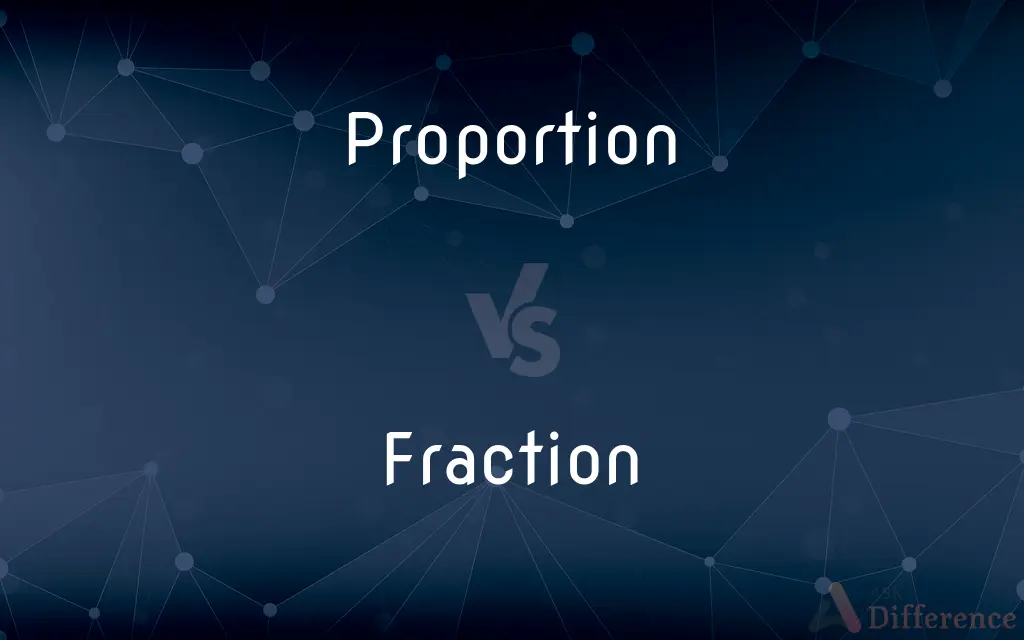Proportion vs. Fraction — What's the Difference?
By Urooj Arif & Maham Liaqat — Updated on March 31, 2024
Proportion refers to the relationship between parts of a whole, often expressed as a ratio, while a fraction represents a part of a whole as a numerical division, showing how many parts of a certain size there are.

Difference Between Proportion and Fraction
Table of Contents
ADVERTISEMENT
Key Differences
Proportion is a concept used to describe the relation or comparison between quantities, demonstrating how one quantity is related to another or to a whole. It is commonly expressed as a ratio or percentage, indicating the relative size of one part compared to another. Conversely, a fraction is a mathematical expression that divides a whole into parts, represented by two numbers: the numerator and the denominator, where the numerator indicates how many parts are taken out of the denominator, the total number of equal parts.
While proportion is used to compare or express the relation between quantities, highlighting how quantities scale or change in relation to each other, fractions are specifically used to describe how much of something exists. For example, a fraction can express the ingredients needed for a recipe, whereas a proportion can compare the amount of one ingredient to another or to the whole recipe.
In terms of application, proportions are widely used in various fields, including mathematics, science, art, and everyday life, to maintain consistency, scale models, or convert measurements. Fractions, on the other hand, are fundamental in mathematics for operations involving parts of wholes, such as measuring, dividing, and representing numbers between zero and one or between whole numbers.
The concept of a proportion can extend beyond numerical comparisons to include broader relationships and balances, such as the aesthetic proportions in design and art, or the proportionality principles in law and ethics. Fractions, however, remain a purely numerical representation, crucial for precise calculations and measurements.
Understanding proportions is essential for grasping concepts of ratio, rate, and percentage, facilitating comparisons and problem-solving in a wide range of contexts. Fractions are indispensable for understanding division, parts of a whole, and the concept of rational numbers, serving as a foundation for more advanced mathematical operations and theories.
ADVERTISEMENT
Comparison Chart
Definition
A relationship between parts or quantities, often expressed as a ratio or percentage.
A numerical division of a whole into parts, represented by a numerator over a denominator.
Expression
As a ratio (1:2), percentage (50%), or part-to-whole relationship.
As a division (1/2), indicating parts of a whole.
Use
To compare quantities, scale models, or maintain consistency.
To represent parts of a whole, measure, and divide.
Application
Broad, including mathematics, science, art, and everyday situations.
Primarily mathematical, for precise calculations and understanding division.
Beyond Numbers
Can relate to aesthetic, ethical, or legal proportions.
Strictly numerical, representing quantities between 0 and 1, or between integers.
Compare with Definitions
Proportion
A comparative relation between quantities.
The proportion of water to flour in bread dough is crucial for texture.
Fraction
A way to represent division of a whole.
One-half of the cake is represented as 1/2.
Proportion
Extends to principles and ethics.
Laws are based on the proportionality of punishment to the crime.
Fraction
Used in mathematical operations.
Adding fractions requires a common denominator.
Proportion
Often used to maintain balance.
Architects consider the proportion of windows to wall space for aesthetic balance.
Fraction
Essential for precise measurements.
She cut the fabric into fractions of a yard.
Proportion
Can be expressed in various forms.
The proportion of students to teachers is 20:1.
Fraction
Can indicate parts between whole numbers.
He owns a fraction of the company, precisely 1/10.
Proportion
Applies to scaling and models.
The model was built in a 1:100 proportion to the original building.
Fraction
Consists of a numerator and denominator.
In the fraction 3/4, 3 is the numerator, and 4 is the denominator.
Proportion
A part, share, or number considered in comparative relation to a whole
The proportion of greenhouse gases in the atmosphere is rising
Fraction
(Mathematics) An expression that indicates the quotient of two quantities, such as 1/3 .
Proportion
Adjust or regulate (something) so that it has a particular or suitable relationship to something else
A life after death in which happiness can be proportioned to virtue
Fraction
A disconnected piece; a fragment.
Proportion
A part or amount considered in relation to a whole
What is the proportion of helium in the atmosphere?.
Fraction
A small part; a bit
Moved a fraction of a step.
Proportion
A relationship between things or parts of things with respect to comparative magnitude, quantity, or degree
The proper proportion between oil and vinegar in the dressing.
Fraction
A chemical component separated by fractionation.
Proportion
A relationship between quantities such that if one varies then another varies in a manner dependent on the first
"We do not always find visible happiness in proportion to visible virtue" (Samuel Johnson).
Fraction
A part of a whole, especially a comparatively small part.
Proportion
The agreeable or harmonious relation of parts within a whole
The statue seems out of proportion.
Fraction
(arithmetic) A ratio of two numbers (numerator and denominator), usually written one above the other and separated by a horizontal bar called the vinculum or, alternatively, in sequence on the same line and separated by a solidus (diagonal bar).
Proportion
Often proportions Dimensions; size
First measure the proportions of the room.
Fraction
(chemistry) A component of a mixture, separated by fractionation.
Proportion
(Mathematics) A statement of equality between two ratios. Four quantities, a, b, c, d, are said to be in proportion if a/b = c/d .
Fraction
(Christianity) In a eucharistic service, the breaking of the host.
Proportion
To adjust so that proper relations between parts are attained
Have you proportioned the oil in the dressing properly?.
Fraction
A small amount.
Proportion
To form the parts of with balance or symmetry
The artist proportioned the figure nicely.
Fraction
(archaic) The act of breaking, or state of being broken, especially by violence.
Proportion
(countable) A quantity of something that is part of the whole amount or number.
Fraction
To divide or break into fractions.
Proportion
(uncountable) Harmonious relation of parts to each other or to the whole.
Fraction
The act of breaking, or state of being broken, especially by violence.
Neither can the natural body of Christ be subject to any fraction or breaking up.
Proportion
(countable) Proper or equal share.
Fraction
A portion; a fragment.
Some niggard fractions of an hour.
Proportion
The relation of one part to another or to the whole with respect to magnitude, quantity, or degree.
The proportion of the parts of a building, or of the body
Fraction
One or more aliquot parts of a unit or whole number; an expression for a definite portion of a unit or magnitude.
Proportion
A statement of equality between two ratios.
Fraction
To separate by means of, or to subject to, fractional distillation or crystallization; to fractionate; - frequently used with out; as, to fraction out a certain grade of oil from pretroleum.
Proportion
The "rule of three", in which three terms are given to find a fourth.
Fraction
A component of a mixture that has been separated by a fractional process
Proportion
Size.
Fraction
A small part or item forming a piece of a whole
Proportion
(transitive) To divide into proper shares; to apportion.
Fraction
The quotient of two rational numbers
Proportion
(transitive) To form symmetrically.
Fraction
Perform a division;
Can you divide 49 by seven?
Proportion
To set or render in proportion.
Proportion
To correspond to.
Proportion
Harmonic relation between parts, or between different things of the same kind; symmetrical arrangement or adjustment; symmetry; as, to be out of proportion.
Proportion
The portion one receives when a whole is distributed by a rule or principle; equal or proper share; lot.
Let the women . . . do the same things in their proportions and capacities.
Proportion
A part considered comparatively; a share.
Proportion
The equality or similarity of ratios, especially of geometrical ratios; or a relation among quantities such that the quotient of the first divided by the second is equal to that of the third divided by the fourth; - called also geometrical proportion, in distinction from arithmetical proportion, or that in which the difference of the first and second is equal to the difference of the third and fourth.
Proportion
The rule of three, in arithmetic, in which the three given terms, together with the one sought, are proportional.
Proportion
To adjust in a suitable proportion, as one thing or one part to another; as, to proportion the size of a building to its height; to proportion our expenditures to our income.
In the loss of an object we do not proportion our grief to the real value . . . but to the value our fancies set upon it.
Proportion
To form with symmetry or suitableness, as the parts of the body.
Nature had proportioned her without any fault.
Proportion
To divide into equal or just shares; to apportion.
Proportion
The quotient obtained when the magnitude of a part is divided by the magnitude of the whole
Proportion
Magnitude or extent;
A building of vast proportions
Proportion
Balance among the parts of something
Proportion
Harmonious arrangement or relation of parts or elements within a whole (as in a design);
In all perfectly beautiful objects there is found the opposition of one part to another and a reciprocal balance
Proportion
Give pleasant proportions to;
Harmonize a building with those surrounding it
Proportion
Adjust in size relative to other things
Common Curiosities
Why are fractions important?
Fractions are crucial for understanding division, parts of wholes, and the concept of rational numbers in mathematics.
What is the main difference between a proportion and a fraction?
Proportion is about the relationship between quantities, often as a ratio, while a fraction represents parts of a whole numerically.
Can proportions be represented as fractions?
Yes, proportions can be expressed as fractions to compare parts of wholes, but they more broadly represent comparative relationships.
How can understanding proportions benefit students?
It aids in comprehending ratios, percentages, scaling, and the relevance of relative quantities in various fields.
Can proportions influence decision-making?
Absolutely, in fields like economics, proportions can inform decisions by comparing costs, benefits, and risks.
How do proportions apply in everyday life?
Proportions are used in recipes, scaling objects, converting measurements, and ensuring balance in design and aesthetics.
Why is the concept of a fraction fundamental in mathematics?
It's essential for the accurate representation of quantities less than one, division, and the basics of rational numbers.
What makes a fraction unique from a proportion?
Fractions specifically denote how many parts of a whole are considered, with a clear numerical representation.
Are fractions only used in mathematics?
Primarily, yes, though the concept of dividing or segmenting a whole can apply in general contexts, such as dividing resources.
How do proportions relate to ratios?
Proportions extend the concept of ratios by comparing any two quantities, not just parts of a whole.
What is an example of a proportion in art?
The golden ratio is a famous proportion in art, believed to contribute to aesthetically pleasing compositions.
Is there a visual way to represent fractions?
Yes, fractions are often visually represented by dividing shapes into equal parts and highlighting the considered portion.
What role do proportions play in science?
They are critical in formulating hypotheses, analyzing data, and understanding the relationships between variables in experiments.
Can fractions be negative?
Yes, fractions can represent negative quantities, indicating parts of a whole in a negative context.
How do proportions affect cooking?
Proportions ensure that ingredients are mixed in the right balance for the desired taste and texture of the dish.
Share Your Discovery

Previous Comparison
Romantic vs. Sensual
Next Comparison
White vs. CreamAuthor Spotlight
Written by
Urooj ArifUrooj is a skilled content writer at Ask Difference, known for her exceptional ability to simplify complex topics into engaging and informative content. With a passion for research and a flair for clear, concise writing, she consistently delivers articles that resonate with our diverse audience.
Co-written by
Maham Liaqat














































